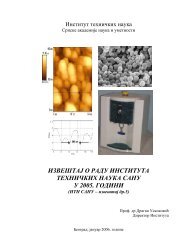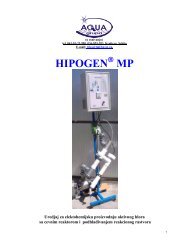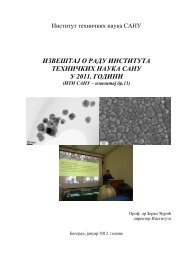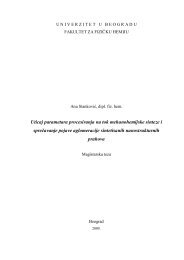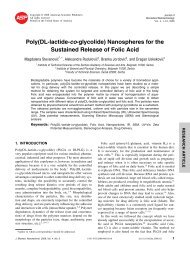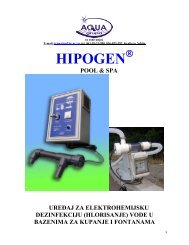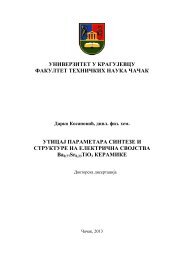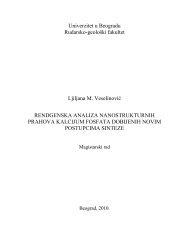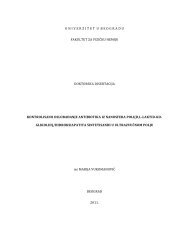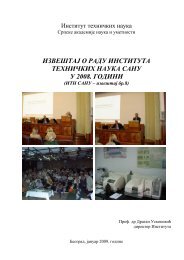Program and the Book of Abstracts (PDF) - Mrs-serbia.org.rs
Program and the Book of Abstracts (PDF) - Mrs-serbia.org.rs
Program and the Book of Abstracts (PDF) - Mrs-serbia.org.rs
Create successful ePaper yourself
Turn your PDF publications into a flip-book with our unique Google optimized e-Paper software.
Tenth Young Researche<strong>rs</strong> Conference – Materials Science <strong>and</strong> Engineering<br />
December 21-23, 2011, Hall 2, SASA, Knez Mihailova 35 & 36, Belgrade, Serbia<br />
VII/5<br />
Aerosol-assisted low-temperature processing <strong>of</strong> colloidal TiO 2 nanoparticles:<br />
two different manne<strong>rs</strong> for improving <strong>the</strong> optical properties<br />
Ivan Dug<strong>and</strong>žić 1 , Dragana Jovanović 2 , Lidija Mančić 1 ,<br />
Zoran Šaponjić 2 , Olivera Milošević 1 , Jovan Nedeljković 2<br />
1 Institute <strong>of</strong> Technical Sciences <strong>of</strong> SASA, Belgrade, Serbia<br />
2 Vinča Institute <strong>of</strong> Nuclear Sciences, Unive<strong>rs</strong>ity <strong>of</strong> Belgrade, Belgrade, Serbia<br />
In order to preserve unique properties <strong>of</strong> TiO 2 nanoparticles towards <strong>the</strong>ir surface modification,<br />
two different approaches <strong>of</strong> low temperature aerosol-assisted processing were performed. Both were<br />
based on colloid precu<strong>rs</strong>or atomization <strong>and</strong> subsequent spray drying at T=150 o C in a hot wall<br />
reactor. In <strong>the</strong> fi<strong>rs</strong>t case, pure TiO 2 colloid precu<strong>rs</strong>or solution was atomized <strong>and</strong> produced<br />
submicronic particles are subsequently modified, while in <strong>the</strong> second one atomization <strong>of</strong> already<br />
modified colloid precu<strong>rs</strong>or solution were done. In both cases <strong>the</strong> TiO 2 surface modification was<br />
achieved with 30 % <strong>of</strong> dopamine. Powde<strong>rs</strong> crystallinity <strong>and</strong> phase composition were studied by X-<br />
ray powder difraction (XRPD), while detailed powde<strong>rs</strong> morphological characterization was<br />
followed using scanning <strong>and</strong> transmission electron microscopy (SEM <strong>and</strong> TEM). Optical properties<br />
<strong>of</strong> <strong>the</strong> surface modified TiO 2 particles were investigated using reflection spectroscopy while <strong>the</strong><br />
binding structure between dopamine <strong>and</strong> <strong>the</strong> surface titanium atoms was investigated by FTIR<br />
spectroscopy.<br />
VII/6<br />
Goethite nanoparticles syn<strong>the</strong>sized with addition<br />
<strong>of</strong> various surface active substances<br />
Alex<strong>and</strong>er N. Antonov 1 , E.A. Kolesnikov 2<br />
1 Moscow State Unive<strong>rs</strong>ity, Moscow, Russia<br />
2 National Unive<strong>rs</strong>ity <strong>of</strong> Science <strong>and</strong> Technology, Moscow, Russia<br />
To receive monosized goethite (α-FeOOH) nanoparticles in <strong>the</strong> process <strong>of</strong> chemical<br />
precipitation from iron salt <strong>and</strong> alkali various surface active substances (SAS) were added in water:<br />
C 12 H 25 NaO 4 S (SDS), C 12 H 38 ClN (CPC) <strong>and</strong> EDTA C 10 H 14 O 8 N 2 Na 2 (complexon). Investigations by<br />
means <strong>of</strong> TEM <strong>and</strong> Mossbauer spectroscopy show, that addition <strong>of</strong> CPC increases <strong>the</strong> amount <strong>of</strong><br />
small particles with sizes <strong>of</strong> 2-5 nm in comparison to goethite nanoparticles, obtained without SAS.<br />
However in case <strong>of</strong> SDS <strong>and</strong> EDTA <strong>the</strong> growth <strong>of</strong> well-crystallized goethite particles with sizes <strong>of</strong><br />
about 100*20nm takes place.<br />
Thermomagnetic analysis revealed unusual behaviour: in <strong>the</strong> temperature region <strong>of</strong> 200-500 o C<br />
peaks <strong>of</strong> magnetization are occurred. These peaks can be explained by transformations <strong>of</strong> various<br />
<strong>org</strong>anic Fe 3+ - complexes, formed on <strong>the</strong> nanoparticles surface, under SAS influence to magnetic<br />
phases.<br />
29





